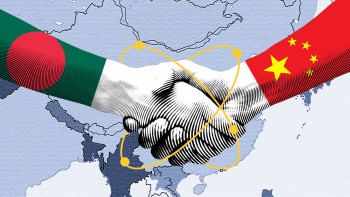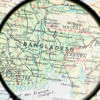The dragon and the delta

There are rivers, and then there are currents. The rivers of Bangladesh—Padma, Meghna, Jamuna—run deep, shaping land, destiny and commerce. But currents, the unseen forces that dictate the flow of history, are harder to chart.
The tides of geopolitics, the undercurrents of trade wars, the ripples of power shifts—all dictate the future of nations. In this interplay, Bangladesh and China are not merely drifting neighbours; they are architects of a shared destiny, bound by history, ambition and a blueprint for the future.
Recent events have added urgency to this discourse. A 21-member delegation, of which I was a part, embarked on a journey to Beijing, not as idle emissaries but as active negotiators of Bangladesh's place in the unfolding Asian century. In meetings with high-ranking officials of the Chinese Communist Party (CPC) and the foreign ministry, we presented a vision for an elevated partnership. The response? Enthusiastic endorsement.
What followed was not mere diplomatic pleasantries but a recognition: Bangladesh is ready to be more than a recipient of Chinese investments; it is ready to be a strategic collaborator, a manufacturing force, and a regional stabiliser.
Bengal's entanglement with China predates modern geopolitics. In the fourth century, Fa-hsien chronicled the culture of the Gangetic delta, and in the seventh century, Hiuen Tsang met King Harshavardhana, bearing testimony to ancient ties of scholarship and trade. Fifteenth century navigator Ma Huan, who sailed under Admiral Zheng He, described Bengal's bustling ports, its Muslim rulers, and the mercantile energy that linked it to the Chinese court.
In matters of spirit, even the revered Shah Jalal of Sylhet found a place in Chinese records, further cementing centuries-old exchanges.
These were not just transactions; they were threads in a grander fabric, one that today unfolds in the shape of economic corridors, industrial parks, and transcontinental supply chains.
As China ascends to the heights of artificial intelligence and high-tech industries, it leaves behind a vacancy—a space for manufacturing to migrate. Vietnam has seized the opportunity. So has Indonesia. Why not Bangladesh?
DeepSeek, China's latest foray into AI, signals a shift, one where China will export not just goods but knowledge while relocating its traditional industries elsewhere. Bangladesh, with its labour force, its strategic location, and its deepening ties through the Belt and Road Initiative (BRI), must make the case for itself. The investments that were put on hold due to political uncertainties must be rekindled, and Bangladesh should position itself as the next re-export hub for Chinese goods, optimising trade routes, reducing costs, and sustaining China's access to global markets.
Of all the shadows looming over Bangladesh, none is darker than the crisis in Myanmar. The Rohingya crisis is not just a humanitarian catastrophe; it is a geopolitical fault line. Without stability in Myanmar, Bangladesh's security remains fragile.
China's influence in Naypyidaw is undeniable. Yet, for too long, Bangladesh has been a passive observer, waiting for Beijing to pressure the Myanmar junta into action. The delegation pressed the case: China must do more. The repatriation of the Rohingya, the stabilisation of Rakhine state, and the assurance that Myanmar does not descend into prolonged chaos are matters that Beijing cannot afford to ignore. The response? A willingness to engage, to mediate, and to ensure that the next Bangladesh government finds a stable eastern frontier.
The world is in flux. The US, China and India form a triad of competing interests in South Asia. Bangladesh's geography has placed it at the crossroads of this rivalry, but geography is not destiny—policy is. Rather than picking sides, Bangladesh can be a bridge between these global powers, leveraging its historical closeness with India, its growing ties with China, and its strategic importance to the US.
This is not about neutrality but about active diplomacy—playing the role of mediator, connector, and stabiliser in an increasingly multipolar world.
The meetings in China were not just about rhetoric. They were about plans, commitments, and structured collaboration. The 11-point charter, adopted by the delegation and welcomed by the CPC, outlines the next steps: strategic alignment for regional stability; positioning Bangladesh in global trade shifts; strengthening logistics and trade routes; advancing technological partnerships; expanding trade and cultural exchange; building a sustainable industrial base; expanding military manufacturing ties; leveraging China's diplomatic influence for Rohingya repatriation; Teesta River water management; accelerating investment in transport and communications; and developing banking and financial collaboration.
The enthusiasm from China's leadership was not just symbolic. These initiatives are actionable, transformative, and most importantly, mutually beneficial.
The rivers in Bangladesh will always flow towards the sea, but the currents of history can be steered. The Bangladesh-China relations have entered a new era, one where Bangladesh is not just a recipient of investment but a co-creator of the future. The foundation has been laid; the agreements have been acknowledged. The challenge, now, is execution. Will Bangladesh rise to claim its place as a hub of manufacturing, defence co-production, and geopolitical mediation? Or will it allow others to dictate the terms of engagement? The moment demands action, vision, and leadership.
The tide is rising. Bangladesh must set sail.
Bobby Hajjaj is faculty member at North South University (NSU). He can be reached at [email protected].
Views expressed in this article are the author's own.
We welcome your contributions and analysis of global events, and responses to our articles. To submit articles to Geopolitical Insights, please send an email to [email protected].
Follow The Daily Star Opinion on Facebook for the latest opinions, commentaries and analyses by experts and professionals. To contribute your article or letter to The Daily Star Opinion, see our guidelines for submission.


 For all latest news, follow The Daily Star's Google News channel.
For all latest news, follow The Daily Star's Google News channel. 









Comments